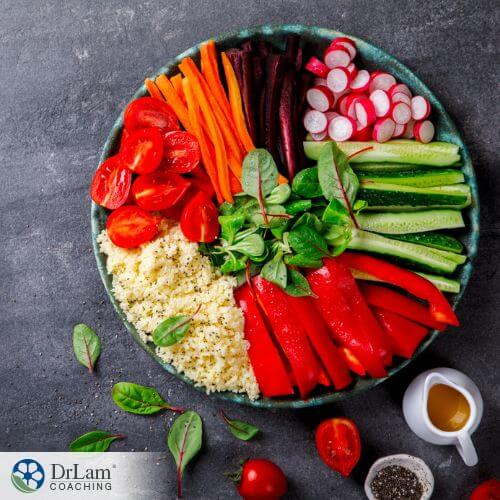 If you look at the Standard American Diet, there’s not much variety in the color of the food. It’s made up of a lot of white, brown, and yellow foods like pasta, bread, potatoes, rice, eggs, sausages, chicken, and beef. And the cooking method usually involves frying in some kind of oil or animal fat. And while some of these foods can be made healthier, a plate that lacks color lacks nutrients. Eating the rainbow is the antidote to that problem.
If you look at the Standard American Diet, there’s not much variety in the color of the food. It’s made up of a lot of white, brown, and yellow foods like pasta, bread, potatoes, rice, eggs, sausages, chicken, and beef. And the cooking method usually involves frying in some kind of oil or animal fat. And while some of these foods can be made healthier, a plate that lacks color lacks nutrients. Eating the rainbow is the antidote to that problem.
You’ve heard that term before. But what does “eating the rainbow” actually mean for your health? How do you go about doing so in a way that’s easy, sustainable, and gives you the biggest phytonutrient bang for your buck?
That’s what this article is all about. And we hope that you’ll be inspired to begin implementing some dietary changes as soon as you finish reading. The benefits you’ll reap will be very much worthwhile.
The rainbow colors in plants actually come from the phytonutrients in them. And, in fact, the richer or deeper the color, the more potent the nutrients. That’s why highly processed grains, like white bread or white rice, are lacking in health benefits. They were stripped of their nutrients when they were processed and bleached. But something as vibrant as a blueberry? You know how packed with vitamins and minerals that is just by looking at it.
In order to begin eating the rainbow and understanding what nutrients you’re getting, we’ll be dividing this article into red, orange, yellow, green, and blue sections. Each section will talk about the specific foods in each category and which organs or systems they benefit the most. But before we get into these specifics, it’s also good to get an understanding of what the different types of plant nutrients are.
First, there are the macronutrients. You know what those are. They’re the proteins, fats, and carbohydrates. And, before you wonder what fruits or vegetables contain protein or fat, there are other plant-based foods that should be included in a healthy diet, such as:
Those are all plant foods, too. And some are great sources of protein, such as beans and legumes, while others are great sources of healthy fats, like nuts and seeds. It is the case, however, that one of the greatest macronutrient benefits of eating more plants is the fiber content. The Standard American Diet is very low on fiber. With our adrenal fatigue clients, we focus on nutrition as the cornerstone of the recovery program. And one goal is often to slowly increase our clients’ fiber intake.
There are two different types of fiber, both of which are contained in most plant foods. There’s soluble fiber and insoluble fiber.
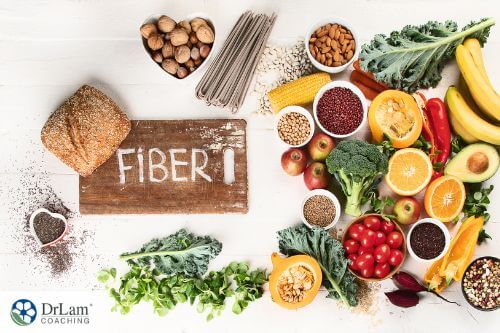 Soluble fiber is beneficial for your gut microbiome. It feeds the “good bacteria” in your gut, and a healthy gut and microbiome are central to overall health. Soluble fiber also helps slow down the release of glucose as your gastrointestinal (GI) tract digests food. Since having stable blood sugar levels are another key to good health, that means that the soluble fiber in plant-based meals is a two-for-one.
Soluble fiber is beneficial for your gut microbiome. It feeds the “good bacteria” in your gut, and a healthy gut and microbiome are central to overall health. Soluble fiber also helps slow down the release of glucose as your gastrointestinal (GI) tract digests food. Since having stable blood sugar levels are another key to good health, that means that the soluble fiber in plant-based meals is a two-for-one.
But that’s not all. Soluble fiber also helps reduce the absorption of fat, which can help a lot with weight loss. And, as mentioned earlier, weight gain (especially around the belly) is one of the symptoms of adrenal fatigue. Lastly, soluble fiber lowers cholesterol and is good for heart health. And since cardiovascular disease is the leading cause of death in the world, increasing fiber intake should be something all healthcare professionals advocate for.
As for insoluble fiber, that’s what helps your gut motility. This is the movement of the food through your GI tract and the regularity of bowel movements. It also helps prevent constipation.
Aiming for 28-35 grams a day is ideal, and it’s important to get it from different sources of plant foods. As we’ll repeat throughout the article, the more variety on your plate, the better. But not everyone can tolerate a quick or dramatic increase in fiber intake. With our clients, we like to do so gradually, taking stock along the way and making adjustments if needed. If you’d like to learn more about our unique approach to nutrition and nutrition coaching, we’d be happy to offer you a free initial consultation with one of our coaches.
Eating the rainbow and getting that variety of different colors and types of plant foods not only helps give you all the macronutrients you need, but it also supplies your body with a range of important vitamins and minerals. When it comes to micronutrients for adrenal fatigue recovery, the following are some of the ones we like to consider when designing a client’s nutrition plan:
There are a few other vitamins, minerals, and nutrients that can really help with health conditions and adrenal fatigue recovery as well. Some include Coenzyme Q10, digestive enzymes, collagen, D-ribose, and inositol. Also, some of the phytonutrients we’ll mention in the different color categories of eating the rainbow are especially helpful, such as quercetin and bromelain.
 However, before we get into how these nutrients affect your body, first you have to understand how your body works together as a whole. Eating the rainbow is great for every aspect of your health. And we will get into the details of how each color category affects specific systems and organs. However, many of these systems and organs are involved in your body’s stress response, and this is also one of the main ways many of these organs can develop problems as well. Understanding how your body works together to handle stress is key to understanding how to best use these nutrients.
However, before we get into how these nutrients affect your body, first you have to understand how your body works together as a whole. Eating the rainbow is great for every aspect of your health. And we will get into the details of how each color category affects specific systems and organs. However, many of these systems and organs are involved in your body’s stress response, and this is also one of the main ways many of these organs can develop problems as well. Understanding how your body works together to handle stress is key to understanding how to best use these nutrients.
Your body’s global stress response is called the NeuroEndoMetabolic (NEM) Stress Response. And it’s composed of six circuits of organs and systems: the Hormone, the Bioenergetic, the Cardionomic, the Neuroaffect, the Inflammation, and the Detoxification circuits. Each circuit is composed of three main components, and some of these components are shared by two circuits. That’s why the NEM is a kind of network and behaves as such.
All of our clients come to us after chronic stress has taken its toll on their health. It dysregulates the NEM and its circuits. Some circuits will be affected more than others, and that’s why we individualize the recovery program. We create a specific diet that can give boosts to the systems and circuits affected the most, and so we sometimes focus on specific colors of foods towards that goal.
For example, because most of our clients suffer from Adrenal Fatigue Syndrome (AFS), we like to include a lot of foods rich in vitamin C. Vitamin C is found in its highest concentration in the adrenal glands, which are the organs that are most exhausted and dysregulated in AFS. Some of the plant foods with the highest concentration of vitamin C are those in the red category.
AFS is a multifaceted condition. It affects pretty much every aspect of health. When your adrenals are dysregulated, their cortisol output is also dysfunctional. And when cortisol is too high or too low for prolonged periods of time, you will start to get AFS symptoms.
Symptoms of AFS include fatigue, weight gain, brain fog, sleep disturbances, anxiety, mild depression, hair loss, loss of libido, PMS, infertility, dry skin, lowered immunity, chronic inflammation, hypoglycemia, salt and sugar cravings, food and drug sensitivities, heart palpitations, estrogen dominance, blood pressure instability, and an inability to handle stress.
The reason the symptoms are so varied is because of the different NEM circuits involved. Your adrenals are part of your Hormone Circuit, and they’re your NEM’s first responders. When they get overworked, they will affect all the other components of your NEM. But, depending on your medical history and general health, you’ll likely have a combination of the above symptoms that’s different from another person with AFS.
That means we have to customize your nutrition plan accordingly. For example, let’s say your main complaints are Neuroaffect related, such as brain fog, anxiety, depression, and difficulty sleeping. We would then focus on including more of the blue-purple category of foods for you. In contrast, for someone complaining of fertility problems, we’d focus on including more orange foods in their diet.
Still, as you’ll see later, the most important part of a nutrition plan is not so much on this micro-level. It has to do with creating diversity in your diet – eating the rainbow. That way you get all the macronutrients, micronutrients, and phytonutrients you need.
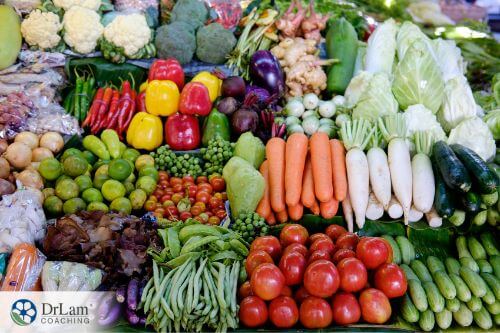 Now that you know how your organs and systems work together to respond to stress - and are more likely to develop imbalances - we can get into how certain phytonutrients help fortify your body against those imbalances.
Now that you know how your organs and systems work together to respond to stress - and are more likely to develop imbalances - we can get into how certain phytonutrients help fortify your body against those imbalances.
When we talk about eating the rainbow, we’re looking at the different colors of plant foods that make up that rainbow. And, as we mentioned, it’s the phytochemicals in those plants that give them their colors. These colors are also what can help you determine the types of benefits you’ll get from them. Of course, there are overlaps and most plants contain a combination of different phytochemicals. But the categorization does simplify things and will help you roughly determine what nutrients you’re getting and what you need more of.
Let’s start.
Red plant foods are great for your immune health. They contain important antioxidants and have anti-inflammatory properties. Most people think of tomatoes when talking about red plant foods. But there are many others to consider including in your diet, such as:
As you can see, you don't have to stick to citrus fruits to improve your immunity. In fact, red bell peppers, rosehips, and cherries have some of the highest content of vitamin C.
Red foods contain alkaloid phytochemicals. Specifically, these include:
If you have AFS, your immune system might be compromised. You might have noticed you get more frequent colds and flu and you have a harder time recovering from infections. It’s also possible your Inflammation Circuit is dysregulated. These foods can help reduce that inflammation and improve your immune system.
Orange fruits and vegetables are rich in carotenoids, especially beta-carotene. They help regulate certain endocrine functions, like ovulation and fertility. Some great orange plant foods to add to your diet include:
Orange plant foods contain fat-soluble antioxidants. These can actually be stored in your adipose tissue, or fat, which is concentrated in the brain, ovaries, breasts, and skin. Beta-carotene seems to be useful for both male and female fertility, helping reduce the time to pregnancy in women and helping increase sperm concentration in men. But orange foods contain other phytonutrients as well, including:
If your Hormone Circuit is dysregulated, your entire endocrine system will be affected. And if your reproductive organs, such as the ovaries or testes, are the Hormone Circuit component affected the most by the dysregulation, then incorporating more orange foods is a good idea.
 The main phytonutrient contained in yellow plant foods is bioflavonoids. And they are good for your microbiome’s health as well as for metabolic detoxification. Yellow foods are also very high in fiber content, so they benefit the microbiome in that way as well. Plus, as noted above, fiber helps regulate blood sugar levels and improve gut motility and digestive secretions. Taken together, you can see why yellow foods are so good for digestion and gut health.
The main phytonutrient contained in yellow plant foods is bioflavonoids. And they are good for your microbiome’s health as well as for metabolic detoxification. Yellow foods are also very high in fiber content, so they benefit the microbiome in that way as well. Plus, as noted above, fiber helps regulate blood sugar levels and improve gut motility and digestive secretions. Taken together, you can see why yellow foods are so good for digestion and gut health.
Some yellow plant foods to include in your diet when eating the rainbow include:
Other than bioflavonoids, yellow plant foods contain the following phytochemicals:
A healthy microbiome is truly one of the most important aspects of recovering from adrenal fatigue to aim for as well. It’s one of our main aims with our adrenal fatigue nutrition plans. Achieving a healthy gut and microbiome will lead to a cascade of improvements, including less inflammation, stronger immunity, more energy, increased mental clarity, and a better mood. So adding yellow plant foods is a great step to take to support your health.
Green leafy vegetables are known to be extremely beneficial for heart health. In fact, there are some cardiovascular recovery programs, such as Dr. Esselstyn’s program, that mainly revolve around increasing green leafy vegetable intake by manyfold. And although that is a very specific program for very specific health conditions, there is something to be said about how powerful green foods can be. New findings show that just one cup of leafy green vegetables a day can lower your risk of heart disease.
But what is it exactly about leafy greens that’s so special? Well, it’s not one specific thing, although their nitrate content is a big element. Nitrate helps relax and expand your blood vessels. It binds to plaque in your arteries and helps clean them out. But leafy greens also contain vitamin K, one of the least acknowledged but very beneficial vitamins, as well as folate, potassium, and magnesium. All good for heart health.
But green foods go beyond just the leafy kind. There are dozens of possibilities, such as:
Green plant foods are rich in many different phytonutrients, including:
If your Cardionomic Circuit is dysregulated, it’s time to increase your intake of green plant foods. The thing about Cardionomic Circuit dysfunction is that it can start off with mild symptoms, such as heart palpitations once in a while or some blood pressure instability upon standing up. But the progression of such dysregulation can become dangerous quite quickly, with cardiac arrhythmia, tachycardia, POTS-like symptoms, and even damage to the heart muscles.
The science of nutrition for mental health is new but growing. There are many aspects to it. For example, food that helps balance your microbiome ends up affecting your mood because of the gut-microbiome-brain axis. Much of your neurotransmitters are made in the gut and also most chronic inflammation that reaches the brain and nervous system originates in the gut.
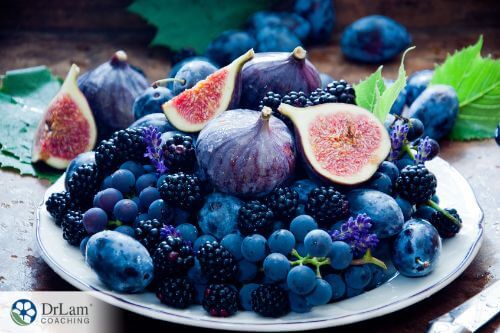 But there are foods that also directly help modulate your mood and brain health. And those fall under the blue-purple category of eating the rainbow. So far, grapes and blueberries have been the most studied, but the phytochemicals they contain are also found in many other foods in this color category, including:
But there are foods that also directly help modulate your mood and brain health. And those fall under the blue-purple category of eating the rainbow. So far, grapes and blueberries have been the most studied, but the phytochemicals they contain are also found in many other foods in this color category, including:
These foods have a combination of different phytochemicals, such as:
These polyphenol-rich foods assist with not only your mood, but also your cognitive health. This can be especially helpful if your Neuroaffect Circuit is affected, and you’re suffering from brain fog and other psychiatric and neurological symptoms. You can see benefits in your learning and memory, as well as the health of your neurons. And, of course, we can’t forget their powerful antioxidant content.
But what exactly do antioxidants do? And how do they work? That’s actually an interesting topic unto itself, and it plays an important role in the benefits of eating the rainbow.
Oxidative stress is a type of stress that your body deals with on a daily basis. It’s when the free radicals outnumber the antioxidants that neutralize their harmful activity. What free radicals do is steal electrons from stable molecules in your system. The reason they do that is because they are unstable themselves - they lack an electron. And when they steal electrons, they destabilize the molecules they took them from, turning them into free radicals themselves.
This process happens in your body all the time. It’s a byproduct of many physiological functions. But if you’re healthy, you’ll have enough antioxidants to balance them out. Antioxidants freely give up some of their electrons to these free radicals and thus neutralize them.
If you’re not getting enough antioxidants through your diet, and if you’re exposed to stress, whether physical or psychological, then you’re at risk of increased oxidative stress. At some point, this oxidative stress might turn into oxidative damage. This can also increase inflammation in your body, and chronic inflammation is a contributing cause of many chronic conditions, including cancer, mental health issues, adrenal fatigue, neurodegeneration, gastrointestinal problems, and cardiovascular issues.
Eating the rainbow is one of the best ways to combat this problem. The antioxidant power of vibrantly colored plant foods has been well studied. And each plant food has a network of different antioxidants and phytochemicals to help support your body.
Finally, eating the rainbow is an excellent way to naturally boost your Detoxification Circuit. Polyphenols and omega-3 fatty acids can help decrease the inflammation that results from exposure to toxins. Meanwhile, folates aid the methylation process that removes toxic metals from the system.
Herbs and spices are especially helpful for detoxification. They have anti-inflammatory, anti-viral, and anti-bacterial properties as well as immune-boosting effects. You can add things like turmeric, cinnamon, mint, ginger, rosemary, and cloves to your cooking to enhance the flavor as well as for medicinal purposes.
If you want to get all the nutrients and the different types of antioxidants in your diet on a regular basis, you’ll need to use a two-pronged approach.
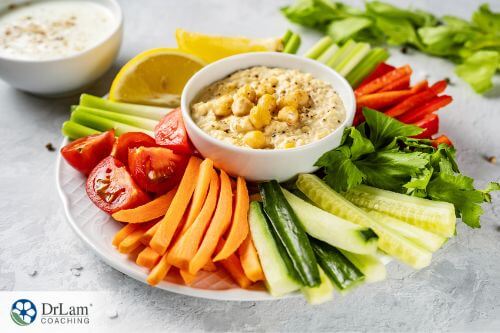 The first is to have a diversity of plants in your daily meals. That means combining different colors together on the same plate. Many traditional dishes from around the world do that anyway, but if you’ve been following a Standard American Diet you might need to make a conscious effort at first.
The first is to have a diversity of plants in your daily meals. That means combining different colors together on the same plate. Many traditional dishes from around the world do that anyway, but if you’ve been following a Standard American Diet you might need to make a conscious effort at first.
For example, you can combine all the colors in one salad by mixing some leafy greens with purple cabbage, shredded carrots, red beets, and yellow onion. Add to that some healthy fats from avocado, nuts, seeds, or olive oil. Plus a grilled wild-caught salmon steak on top. Now you have a perfect adrenal fatigue recovery meal that is satiating, nutrient-dense, anti-inflammatory, blood sugar-stabilizing, and packed with antioxidants. If you want to go the extra mile, you might want to top it off with some sauerkraut, kimchi, or other fermented food to boost your microbiome’s health.
The second part of the approach is to rotate your foods. If you eat the same thing every day, you’ll still be missing out on some nutrients. To avoid this, you’ll want to create a menu of a few simple dishes that include different red, orange, yellow, green, and blue-purple foods.
If variety and rotation in your diet sounds overwhelming, you’re not alone. Many people have this worry when thinking about changing their diet. But it’s always possible to start simple and go slowly. Start with just a couple of new dishes at a time for a while. Then increase to more dishes per day with rainbow fruits and vegetables.
With our nutrition programs, we also take into consideration the time, effort, and experience levels each client is able to bring to a diet change. Some people want to experiment and change their menus frequently; otherwise, they get bored. Some are experienced cooks and enjoy creating their own unique combinations that we couldn’t think of ourselves. And some people need to change their diets slowly, a little at a time. Everyone is different; that’s why nutritional coaching has to be individualized. As long as the foundation is correct, there is a lot of room for creativity.
Recently, there has been some concern about what some people call antinutrients. These are compounds found in plants that have been under speculation as to whether they’re harmful or not. Some of these include oxalates, phytates, lectins, phytoestrogens, and tannins.
Let’s take phytoestrogens as an example. Phytoestrogens are compounds that are very similar to the estrogen hormone your body naturally synthesizes. So they may mimic its action. The concern stems from what excess estrogen could do to reproductive health and hormone balance overall.
With adrenal fatigue, estrogen dominance is quite common. Estrogen dominance is the relative dominance of estrogen over progesterone in women and over testosterone in men. And it happens naturally with age, as progesterone and testosterone levels decline faster than estrogen. It can cause unwanted side effects in both men and women. It also creates issues with fertility and reproduction.
 But the natural decline can be exacerbated by exposure to excess xenoestrogens, which are estrogens from an external source. Some harmful xenoestrogens come from certain chemicals in beauty products, chemicals used in agriculture, plastics, and environmental toxins. And there’s not much dispute about whether those are harmful for hormone balance or not. We know they are.
But the natural decline can be exacerbated by exposure to excess xenoestrogens, which are estrogens from an external source. Some harmful xenoestrogens come from certain chemicals in beauty products, chemicals used in agriculture, plastics, and environmental toxins. And there’s not much dispute about whether those are harmful for hormone balance or not. We know they are.
But with phytoestrogens, which come from plants, the verdict is not yet clear. Some research suggests that, actually, phytoestrogens can help reduce estrogen dominance by competing with excess estrogen by binding at estrogen receptors.
This lack of clarity is similar with other so-called antinutrients. But there may be some truth to the idea that certain people with certain conditions, such as those with specific types of autoimmunity, may be more susceptible to the harmful effects of these compounds. For most people, however, the benefits of eating more plants far outweigh any possible risks.
Eating the rainbow is easy. It just takes a gradual shift from processed foods to including more and more plant foods. The different colors of the rainbow – red, orange, yellow, green, and blue – all signify different combinations of nutrients. The phytochemical content of the plant foods is what gives them their color, but also some of their most powerful health benefits.
If you have NEM dysregulation, you can create a nutrition plan that includes specific colors that correspond to the specific organs and systems you want to improve. For example, those with Cardionomic Circuit dysfunction should aim to eat more green foods since they’re good for the cardiovascular system. Those with Inflammation Circuit dysfunction can try incorporating more red and yellow foods as the first helps with immunity and the second helps with gut and microbiome health. And those with Hormone Circuit problems could focus on including more orange foods.
There are so many different ways to include these foods, and the best approach would be to diversify. You can do that by rotating the colors and foods to ensure you get all the nutrients you need.
We can help you get started on this journey, as well as answer any health questions or help you develop recovery goals. Call us at +1 (626) 571-1234 for a free initial consultation to talk to one of our expert coaches.
Eating the rainbow means including red, orange, yellow, green, and blue foods in your meals. The richer the color, the better. And the more variety, the better as well. But what does each color provide in terms of health benefits? We outline those in this article.
